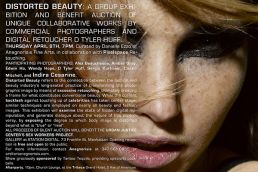From April 8 – May 6, 2010 “Distorted Beauty” group exhibition and benefit auction was held at the Gallery at Station Digital on Franklin Street in New York City. Works by photographers Indira Cesarine, Alex Beauchesne, Amber Gray, Edwin Ho, Wendy Hope, D Tyler Huff, Sergio Kurhajec, and Caitlin Mitchell were auctioned off to benefit the Urban Justice Center’s Sex Workers Project. The event was curated by Danielle Ezzo of Anagnrisis Fine Arts in collaboration with Pixelspace.
Photographer Indira Cesarine exhibited an image of model Edda Petursdottir, that was retouched, but not in the traditional way. In a statement against over perfected beauty retouching, her image, retouched by Tyler Huff, left every imperfection on the face, and even emphasized some elements such as freckles, that are often removed by retouchers for beauty publications and advertising. High-resolution digital photography is so detail-oriented, nothing is left to the imagination. Unlike the grain of film, it is completely unforgiving, showing every hair and pore almost as if viewed through a magnifying glass. Our society has become so used to seeing overly retouched images, a beauty portrait such as this one, with visible facial hair and pores, would be considered almost grotesque. The ideal of beauty has been pushed to such an unrealistic place through the saturation in the media of over-retouched images forces one to question the fundamentals of what we are saying about women in our society. Leaving a beauty image unretouched becomes in essence is a statement against the misogyny of over-retouching.
The theme of the “Distorted Beauty” exhibit refers to the connection between the fashion and beauty industry’s long-seated practice of transforming the photographic image by means of excessive retouching, ultimately creating a frame for what constitutes conventional beauty. While the current backlash against touching up of celebrities has taken center stage, similar techniques are employed on nearly all beauty and fashion images. The exhibition examined the state of hidden digital manipulation, and aimed to generate dialogue about the nature of this controversy, by exposing the degree to which body image is distorted beyond what is considered “real.”


